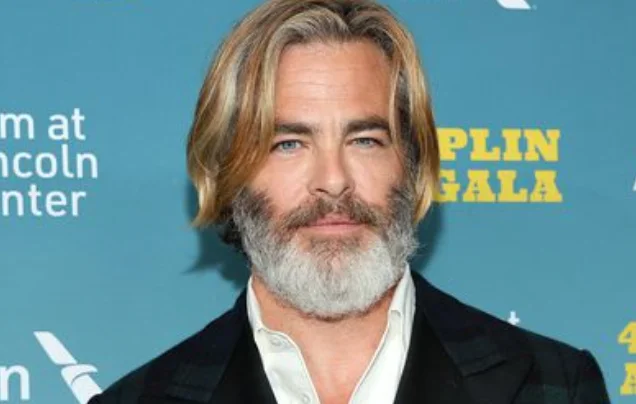Fans were shocked to see Chris Pine switch up his clean-cut look for a shaggy beard and long hair, a huge change for the actor who played the sexy Starfleet captain on Star Trek.
Refined yet rugged, the DC Comics star is giving off Big Lebowski vibes, and fans are saying the 43-year-old heartthrob looks “raggedy” and unrecognizable.
Keep reading to learn what people are saying about Pine!
When Chris Pine was 29, he played James T. Kirk in the 2009 Star Trek reboot, the popular sci-fi franchise that gained a whole new following of fans who were excited to see his face on the big screen.
Over the past 15 years, the effortlessly handsome star has maintained a clean-shaven, well-coiffed look, nailing every outfit that drapes his toned body.
But now, the 43-year-old star – the son of Robert Pine who starred as Sgt. Joseph Getraer on CHiPs (1977 to 1983) – seems to be embracing a chic but hippy-ish style with a shaggy beard, salt and pepper hair and killer tan.
Rugged and shabby
Ditching his typical preppy look, Pines experienced a physical transformation so intense that many fans didn’t recognize him.
The rugged and shabby look came while he was preparing for his role Poolman, a 2023 box office bomb that he starred, co-wrote, produced and directed.

Embracing his character in the film, Pine fully embodied Darren Barrenman, a “hapless dreamer and would-be philosopher who spends his days looking after the pool of the Tahitian Tiki apartment block in sunny Los Angeles.”
He appeared at the opening of the film with his bushy gray beard and his long blonde hair with gray roots loosely resting over the shoulders of a sand-colored blazer. He added to his outfit a pair of dark gray shorts and a t-shirt that reads, “I [heart] LA.”
Sharing a clip on X that shows Pine at the opening, E! News writes, “[Chris Pine] is just in a silly goofy mood.”
‘Homeless’
Before the opening of Poolman, released in May 2024, fans were shocked to see the heartthrob walking around Los Angeles with wavy salt-and-pepper hair and an untamed beard.
His bright blue eyes were hidden by dark sunglasses and his white tank top showed his toned arms, one hand clutching a mask.
“Looks 55 and homeless! Great character actor!!” writes one fan of the Wonder Woman star becoming his character.
Expressing their genuine concern, a handful of fans wondered if Pine was facing some hard times.
“… he could fit in with the homeless people on the streets there. I guess times are tough for everyone,” said one, while a second adds, “He’s going for the homeless look. Someone toss him a bar of soap, he likely needs a scrubbing.”
A third offers, “He was one nice looking guy, I wonder what happened?”
Then there were the fans who had a hard time recognizing Pine’s chiseled face under the grizzled beard.
“Almost don’t recognize him now. Sad!” says one user, while another writes, “I’m impressed anyone recognized him. He looks raggedy.”
Comparing the star to Jeff Bridges as the eccentric slacker in The Big Lebowski, a third shares: “If they ever remake The Big Lebowski, we know who to get to play The Dude!”

‘Chris Pine is a king’
Meanwhile, throngs of fans loved Pine’s new look and gushed over the actor who played the handsome Lord Deveraux in the Princess Diaries 2: Royal Engagement.
“Yet still fine as f***,” remarks one cyber fan, while a second says, “Still looks great.”
A third writes, “He was a prince. Chris Pine is a king now!”
Offering an explanation to his rough new look, another netizen adds, “Kids, this is what we old folks called ‘getting old.’” The user continues, “Nobody (except maybe Tom Cruise) stays looking the same as we age and get older. You’re welcome.”
MY HUSBAND SPENT OUR FAMILY’S SAVINGS FOR A CAR ON A PARIS TRIP FOR HIS MOM — SO I TAUGHT HIM A LESSON ABOUT FINANCES.

The weight of the betrayal settled in my stomach like a cold stone. Three years. Three years of sacrifice, of pinching pennies and foregoing simple pleasures, all for a car that would keep our family safe. And he’d squandered it. On a whim. On a trip to Paris for his mother.
David, bless his oblivious heart, seemed genuinely surprised by my reaction. He’d always been a mama’s boy, and I’d tolerated it, even indulged it, to a point. But this? This was beyond the pale.
“It’s my money too!” he’d protested, his voice rising in that familiar defensive tone. “She deserves it! You can’t put a price on gratitude.”
I’d simply stared at him, my mind reeling. Gratitude? What about gratitude for the sacrifices I’d made, for the countless hours I’d spent juggling work, kids, and household chores? What about gratitude for the safety of our children?
I knew arguing would be futile. He was locked in his own world of justifications, and I wasn’t about to waste my breath. Instead, I retreated, a quiet fury simmering beneath my composed exterior.
Over the next few days, I played the part of the understanding wife. I smiled, nodded, and even helped him pack his mother’s suitcase. I listened patiently as he recounted his mother’s excited phone calls, her plans for sightseeing and shopping.
But beneath the surface, I was plotting. I was determined to teach him a lesson about finances, about responsibility, about the true meaning of family.
First, I contacted his mother. I explained the situation, the crumbling van, the precarious state of our family finances. She was mortified. She’d always been a sensible woman, and she was appalled by her son’s impulsive decision. She offered to pay for the trip herself, but I declined. Instead, I suggested a compromise. She could still go to Paris, but for a shorter period, a weekend getaway rather than a full week. The difference in cost would be returned to our car fund.
Next, I tackled the issue of David’s “my money too” argument. I opened a joint account, separate from our everyday expenses, and deposited the remaining car fund, along with the money his mother had returned. I then created a detailed budget, outlining our household expenses, including the cost of a new (used) car. I presented it to David, highlighting the glaring discrepancy between our needs and his impulsive spending.
I also introduced him to the concept of “family meetings.” Every Sunday, we would sit down together, discuss our finances, and make joint decisions about spending. The kids were included, too, learning about the value of money and the importance of saving.
Finally, I decided to address the issue of his mother’s constant demands. I didn’t want to create a rift between them, but I needed to establish boundaries. I suggested that we set aside a small portion of our budget for gifts and experiences for both our families, to be agreed upon by both of us.
The changes weren’t immediate. David grumbled about the budget, about the “unnecessary” family meetings. But slowly, he began to understand. He started to appreciate the sacrifices I’d made, the careful planning that kept our family afloat. He even started to enjoy the family meetings, seeing them as an opportunity to connect with the kids and make joint decisions.
The day we drove our newly purchased (used) car home, David looked at me, his eyes filled with a mixture of regret and gratitude. “Thank you,” he said, his voice sincere. “For teaching me.”
I smiled. “We’re a team, David,” I said. “And teams work together.”



Leave a Reply